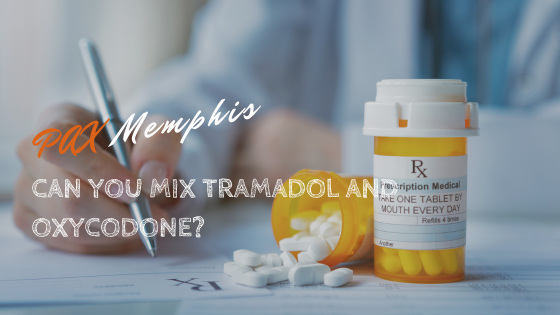Prescription opioids are painkillers that are used before, during, and after surgery as well as to manage pain. There are a variety of different prescription opioids available, each of which varies in strength, dose, and abuse potential.
Two of the most commonly prescribed opioids today are tramadol and oxycodone. Doctors generally only prescribe one opioid at a time due to the risk of abuse, addiction, and overdose, so you should not take tramadol and oxycodone together unless you are directed to do so by your healthcare provider.
What is Tramadol?
Tramadol is an opioid analgesic used to manage pain ranging from moderate to moderately severe. It works by binding to opioid receptors in the brain, altering the perception of pain and providing relief. Tramadol also inhibits the reuptake of serotonin and norepinephrine, contributing to its pain-relieving effects.
Tramadol may be sold under the brand names Ultram, Ultram ER, or ConZip.
Tramadol Side Effects
Common side effects of Tramadol include:
- Nausea
- Vomiting
- Dizziness
- Headache
- Constipation
- Dry mouth
- Sweating
- Fatigue
- Sleepiness
- Loss of appetite
- Nervousness
- Itching
- Rash
- Weakness
- Indigestion
- Diarrhea
- Tremors
- Blurred vision
- Heartburn
- Difficulty breathing
What is Oxycodone?
Oxycodone is an opioid that is commonly prescribed to manage moderate to severe pain. It functions by binding to opioid receptors in the brain and spinal cord, effectively reducing pain sensations.
Oxycodone is the active ingredient in OxyContin, a highly addictive opioid drug that contributed greatly to the opioid crisis. Oxycodone may be sold under various other brand names, including:
- Percocet – oxycodone and acetaminophen (Tylenol)
- Roxicodone – immediate-release oxycodone
- Endocet – oxycodone and acetaminophen (Tylenol)
- Roxicet – oxycodone and acetaminophen (Tylenol)
- Oxyado – immediate-release oxycodone
- Xtampa ER – extended-release oxycodone
- Oxecta – immediate-release oxycodone
Oxycodone Side Effects
Potential side effects of oxycodone include:
- Nausea
- Vomiting
- Constipation
- Dizziness
- Headache
- Dry mouth
- Sweating
- Fatigue
- Sleepiness
- Loss of appetite
- Weakness
- Itching
- Rash
- Blurred vision
- Indigestion
- Diarrhea
- Tremors
- Heartburn
- Difficulty breathing
- Confusion
Comparing Tramadol vs. Oxycodone
Tramadol and oxycodone are both opioids, and they work in similar ways to reduce pain. The main difference between the two is that tramadol is weaker than oxycodone, so it doesn’t produce as strong of effects. As a result, tramadol is more suitable for mild to moderate pain, while oxycodone is best for moderate to severe pain.
As a potent opioid, oxycodone presents a higher risk of dependence and addiction.
Another key difference between tramadol and oxycodone is that oxycodone is a traditional opioid that targets mu-opioid receptors in the brain and spinal cord to alleviate pain. Tramadol, on the other hand, has a dual mechanism for fighting pain. In addition to binding to opioid receptors, it hinders serotonin and norepinephrine reuptake in the brain.
Both tramadol and oxycodone should be administered under the expert guidance of healthcare professionals. Adhering to prescribed dosages and guidelines is essential to minimize risks and garner maximum pain relief.
Can You Mix Tramadol and Oxycodone? Understanding the Risks
Since oxycodone is a powerful opioid and tramadol has opioid properties, they are rarely prescribed at the same time. On the other hand, since tramadol is weaker than oxycodone, its effects will be limited if taken at the same time.
With that said, mixing tramadol and oxycodone can be dangerous. Opioids are central nervous system (CNS) depressants, meaning they slow down vital functions like breathing and heart rate. Taking higher doses than prescribed or mixing two opioids can increase the depressant effects on the body. If you don’t have a tolerance to opioids, taking tramadol and oxycodone together could result in increased adverse side effects, respiratory depression, and the possibility of overdose.
Potential side effects of mixing tramadol and oxycodone include:
- Extreme drowsiness
- Sedation
- Severe confusion
- Dizziness
- Difficulty concentrating
- Impaired judgment
- Poor coordination
- Difficulty breathing
- Respiratory depression
- Unresponsiveness
- Coma
- Death
If you have been prescribed tramadol or oxycodone, be sure to take your medication exactly as directed. If you believe you have been prescribed both medications at the same time by mistake, consult with your healthcare professional.
Other Risks of Mixing Tramadol and Oxycodone
In addition to increasing the risk of side effects and overdose, this drug combination can also pose a threat of causing serotonin syndrome and an increased risk for physical dependence and addiction.
Serotonin syndrome is a potentially life-threatening condition that occurs when there is too much serotonin in the brain at one time. It is characterized by symptoms such as agitation, confusion, rapid heart rate, dilated pupils, and more. Tramadol’s action on serotonin reuptake raises the risk of developing serotonin syndrome when combined with other medications that affect serotonin levels, including oxycodone.
On the other hand, opioid medications carry a risk of dependence and addiction. Mixing two kinds of opioids can create euphoric, addictive effects, potentially leading to a cycle of escalating medication abuse.
Find Help for Opioid Abuse and Addiction
If you or a loved one are mixing tramadol and oxycodone to get high, it may be time to seek treatment. Combining painkillers for enhanced effects is a common sign of opioid addiction.
At PAX Memphis, our team can help guide you through the process of verifying your insurance, finding a detox program, and enrolling in an opioid rehab center that meets your needs. To learn more about your opioid addiction treatment options or for a confidential assessment, please call now.
References:
- Food and Drug Administration (FDA): Tramadol hydrochloride, Retrieved August 2023 from https://www.accessdata.fda.gov/drugsatfda_docs/label/2010/022370s000lbl.pdf
- Drug Enforcement Administration (DEA): Oxycodone, Retrieved August 2023 from https://www.dea.gov/sites/default/files/2020-06/Oxycodone-2020_0.pdf
Medically Reviewed: September 25, 2019

All of the information on this page has been reviewed and verified by a certified addiction professional.










